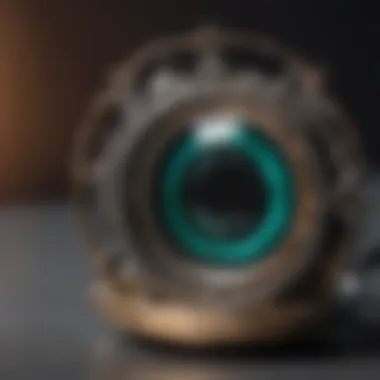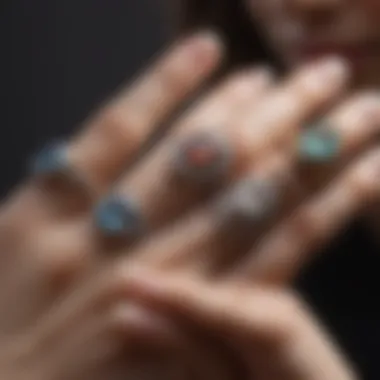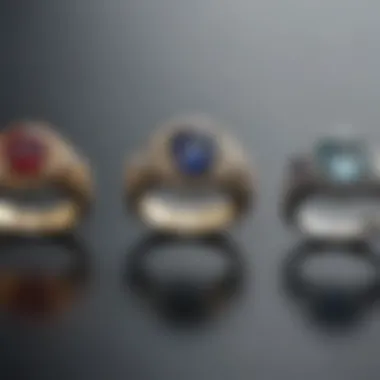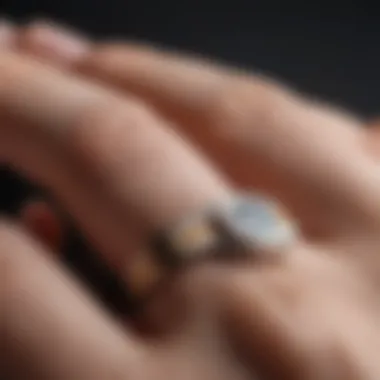How to Accurately Determine Your Ring Size for Men


Intro
Determining the right ring size for men is more than a simple task; it is an essential aspect of jewelry selection. A proper fit ensures comfort and satisfaction, whether the ring is for daily wear or special occasions. The quest for a well-fitting ring can involve various considerations, from personal hand characteristics to environmental factors that may affect sizing.
Understanding the significance of knowing one's ring size is crucial. This knowledge not only enhances the comfort of wearing the jewelry but also elevates the experience of gifting. Choosing the wrong size can lead to frustration, as rings that are too tight can cause discomfort and those that are too loose may risk loss. Therefore, this article will provide a detailed exploration of how to accurately find a man’s ring size, encompassing methods, tips, and important considerations. Armed with this information, readers can approach ring shopping with confidence and clarity.
Methods for Measuring Ring Size
Measuring ring size can be approached in several ways. Here, we will outline a few effective methods:
- Use of a Ring Sizer Tool: These are often available at jewelry stores or online. They usually come as a set of rings in varying sizes. Users can try on the different sizes to find the right match.
- Printable Ring Sizing Guide: Many jewelers provide a printable sizing tool. This involves placing a current ring on the circles printed on the guide to determine the size.
- String Method: Taking a piece of string or a thin strip of paper, wrap it around the base of the finger and mark the point where it overlaps. Measure the length in millimeters and use a conversion chart to find the corresponding ring size.
Always ensure the measurement is taken at normal body temperature, as fingers tend to expand and contract with temperature changes.
Seasonal Considerations in Sizing
It's important to note that hand sizes can change with the seasons. In warmer weather, fingers may swell due to increased blood flow. Conversely, in colder weather, they may contract. Thus, if possible, try to measure finger size during a moderate temperature. This can lead to a more accurate measurement. Additionally, other factors, like hydration and physical activity, can also influence size.
Epilogue
Determining the right ring size for men is an intricate process that incorporates personal preferences, environmental factors, and various measuring techniques. Whether for oneself or as a thoughtful gift, this guide provides a framework to help individuals make informed and confident choices. Understanding your ring size is a step toward ensuring that your jewelry is not just an accessory but a comfortable and cherished item.
Understanding Ring Sizing
Determining an accurate ring size is a critical part of the ring purchasing process. Understanding ring sizing goes beyond knowing a mere number; it encompasses various aspects that ensure comfort and security when wearing the ring. This article aims to guide readers through different methods to find the right size for men's rings, addressing common pitfalls and providing practical solutions.
The Importance of Correct Sizing
Getting the correct ring size is essential for several reasons. First and foremost, a well-fitted ring enhances comfort. A ring that is too tight can cause discomfort, swelling, and even pain. Conversely, a ring that is too loose can slip off easily, risking loss or damage.
Moreover, the emotional significance of a ring cannot be overlooked. Many rings symbolize important life moments such as engagements, weddings or family heritage. A correct fit ensures that the ring can be worn comfortably during these special moments.
In addition, understanding ring sizing can save time and money. Without proper sizing, one may need a resize, which could involve delays and additional costs. Therefore, taking the time to measure accurately will lead to a more satisfying experience.
Common Misconceptions
Many people hold misconceptions about ring sizing that can affect their choices. One common belief is that finger size is consistent throughout the day. However, finger sizes can vary due to multiple factors like temperature and activity level.
Another misconception is related to using irregular calculations, such as
Measuring Techniques
Measuring ring size accurately is pivotal for ensuring comfort and fit. The methods discussed in this section offer clear approaches to help you determine your correct size, whether you are shopping for yourself or selecting a gift. Each technique has its unique benefits and considerations, making it easier to find the right fit for your needs.
Using a Ring Size Chart
A ring size chart is a convenient tool that can simplify the measuring process. These charts typically display different sizes alongside corresponding diameters and circumferences. When utilizing a ring size chart, keep the following aspects in mind:
- Location: Ensure you are looking at a reputable source, as discrepancies may exist between charts.
- Measurement: Measure your finger's diameter accurately and cross-reference that with the chart.
- Unit Systems: Be aware that sizes can vary based on different measurement systems—like US, UK, or European. Make sure you are using the correct chart method based on where you live or shop.


Using a ring size chart can indeed be straightforward. However, it may not account for all factors affecting sizing, such as fluctuating body temperature.
Measuring Existing Rings
If you already own a ring that fits comfortably, you can use it as a reference point. Here’s how to measure an existing ring:
- Select the Ring: Choose a ring that fits well on the finger you wish to size.
- Diameter Measurement: Use a ruler or caliper to measure the inside diameter of the ring. Make sure to measure in millimeters for better accuracy.
- Consult a Sizing Chart: Once you have the diameter, refer to a sizing chart to convert that measurement into a ring size.
This method is effective when you have a suitable ring. However, it does require careful measurement for precise results.
Measuring Finger Circumference
Another reliable method is measuring the circumference of your finger. Here’s a simple step-by-step guide:
- Prepare a Measuring Tape or Cloth: Use a flexible measuring tape, or if you don’t have one, a piece of string or paper can work too.
- Wrap and Mark: Wrap it around the base of the finger where the ring will sit. Mark where the tape meets itself or where you feel the paper overlaps.
- Measure the Length: Lay the string or paper flat and measure the length up to the mark you made. This is your finger's circumference.
- Refer to a Sizing Chart: Take that measurement and check against a ring size chart.
Measuring finger circumference can be influenced by factors like body temperature and humidity, so doing it at different times may provide further clarity.
Using String or Paper
If you do not have a measuring tape on hand, string or paper can also serve as useful tools. To implement this technique, follow these instructions:
- Cut a Strip of Paper or String: Make sure it's long enough to wrap around your finger comfortably.
- Wrap Around the Finger: Secure it gently around the base of the finger, taking care not to wrap it too tightly.
- Mark the Overlap: Just as with the previous methods, mark the point of overlap.
- Measure the Length: Straighten out your string or paper and measure its length. Use the measurement to find your size using a chart.
This method is quite accessible and can yield accurate results if done thoughtfully.
Professional Measurement Services
For the most accurate sizing, consulting a professional jeweler is recommended. Jewelers have specialized tools and experience in determining ring sizes effectively. Some points to consider:
- Measurements: Jewelers often use a series of metal ring sizers to determine size precisely.
- Account for Fluctuations: Professionals can take your measurements at different times to account for size changes.
- Customized Recommendations: Professional services can also recommend adjustments for specific styles or designs.
Engaging a jeweler is particularly useful for unique or intricate designs, ensuring that the fit will be perfect for the recipient.
Factors Influencing Ring Size
Understanding the factors that influence ring size is vital when determining the best fit for a ring. Men’s fingers are not only unique in size but can also change daily based on various physical and environmental variables. Recognizing these influences can lead to better comfort and a more satisfactory jewelry purchase agreement.
Time of Day
The time of day plays a significant role in finger size. In the morning, fingers are typically slimmer due to reduced blood circulation during sleep. By afternoon, fingers may swell slightly due to warmth and increased activity. Therefore, measuring at the same time each day, preferably in the afternoon, can provide a more accurate reading. If measurements are made in the morning, there’s a chance the ring may feel tight later in the day.
Seasonal Variations
Seasons can greatly affect finger size. In summer, heat causes fingers to expand, while in winter, cold weather leads to contraction. Individuals engaged in outdoor activities during warm weather may also notice more significant swelling. To account for this, it's advisable to be aware of seasonal changes and choose a size that would fit comfortably across the year, particularly if the ring is intended for everyday wear.
Body Temperature
A person's body temperature can influence blood flow to the fingers, altering their size. Higher temperatures can lead to temporary swelling, while lower temperatures can cause fingers to shrink. This factor is especially important for men who are active in various climates. For accurate measurements, it is best to take them when calm and at a moderate temperature to avoid misleading results caused by extreme heat or cold.
Weight Fluctuations


Weight is another variable that can affect ring size. Gain or loss in weight can cause fingers to swell or shrink. This factor is often overlooked but can be crucial if you expect significant changes in body weight. It’s advisable to regularly check your ring size if you are on a weight loss or gain journey. An ideal recommendation is to wait until your weight stabilizes before purchasing a ring to avoid possible resizing.
Thus, by considering these factors, one can more accurately determine their ring size, ensuring comfort and a better fit.
Comparative Sizing Standards
Understanding comparative sizing standards is essential for those searching for the correct ring size. Different regions and cultures have their own systems for measuring ring sizes, which can often lead to confusion when purchasing rings. This section explores the variations among sizing standards, particularly between the United States and international systems, and clarifies the differences between men’s and women’s rings. By delving into these nuances, readers will gain a better understanding of how to navigate the complexities of choosing the right ring size.
US vs.
International Sizes
In the United States, ring sizes typically follow a numerical system ranging from 3 to 16, with half sizes also available. This range is derived from the internal circumference of the ring, measured in millimeters. For example, a size 10 corresponds to a circumference of 19.8 millimeters.
In contrast, international sizing systems include various formats, such as the European system which uses an alphanumeric code based on the inner diameter of the ring. Sizes in the UK, for instance, often refer to letters, ranging from A to Z. Different countries can have different measurement standards, complicating the purchasing experience if one is not prepared.
To avoid errors, it is prudent to consult a comprehensive size conversion chart before making a purchase. Here is a simple conversion of sizes:
- US Size 8 = UK Size Q = European Size 18
- US Size 10 = UK Size R = European Size 20
- US Size 12 = UK Size T = European Size 22
This may seem straightforward, but slight variations can still occur due to local practices. Thus, understanding both the US and international systems is vital, especially for online shopping or when considering rings from overseas.
Differences Between Men’s and Women’s Rings
Men’s and women’s rings are not only different in style but also in sizing. Typically, men’s rings tend to be wider and thicker, which influences the fit. A wider band can feel tighter than a thinner one, even if both are the same size.
Key distinctions include:
- Size Range: Generally, men's sizes start from around size 7 and can go up to size 20 or more, while women’s sizes often range from 3 to 9.
- Width and Comfort: The width of the band can also affect the size needed. For example, a size 10 men’s ring that is 8mm wide may fit tighter than a standard 6mm band.
- Styles: Men's rings often feature simpler designs, while women's rings may have intricate detailing, but this depends largely on individual preference.
It’s essential to bear these elements in mind when selecting a ring, as they impact comfort and fit. Understanding these differences can help avoid mistakes and ensure that the ring chosen meets both aesthetic preferences and functional needs.
"Knowing the sizing standards can save you time, money, and frustration in the quest for the perfect ring."
Common Sizing Mistakes
Understanding common sizing mistakes can prevent frustration and ensure that you find the right ring size. Many assume that ring size is a straightforward measurement, but various factors can complicate this process. Avoiding these pitfalls can lead to a better fit and overall satisfaction with your purchase. This section outlines the frequent misjudgments individuals make when determining their ring size.
Overly Tight or Loose Fits
One common mistake is choosing a ring that is either too tight or too loose. A tight fit can lead to discomfort and in some cases, cause circulation issues. On the other hand, a loose ring may slip off easily and become lost.
Wearing a ring that fits properly should feel snug yet comfortable on the finger. To find the right balance, consider trying different sizes. Often, it is beneficial to wear rings of various sizes at different times of the day. A tight ring in the morning may loosen as the day progresses due to natural body changes.
Tips for Choosing the Right Ring Size
Choosing the right ring size is essential for a comfortable and secure fit. This section delves into strategies that can significantly enhance the accuracy of your selection. Understanding various techniques can help one avoid the potential discomfort or hassle associated with ill-fitting rings. Correct sizing ensures not only comfort but also that the ring remains securely in place during daily activities. Moreover, learning to accurately measure can save time and potential extra costs associated with resizing a ring after purchase.
Involving a Friend or Partner
When measuring ring size, involving a friend or partner can provide a helpful perspective. Another person can assist with precise measurements and offer opinions on fit. Their objective view can aid in assessing comfort more accurately. If you are planning a surprise gift, you can discreetly obtain their ring size by working together in a casual way.


- Discreet Inquiry: If you already have a ring size in mind, find the opportunity to subtly ask about their preferences without raising suspicion.
- Assist with Measurement: When measuring, having another person hold the measuring tools can help maintain accuracy. This can reduce potential movement, which might lead to an inaccurate measurement.
- Seek Consensus: Involve them in the decision-making process. Discussing sizes can make the selection more personalized and thoughtful, ensuring the final choice aligns with their comfort and style preferences.
Testing Different Sizes
Testing out various sizes can be an eye-opening experience. It allows for firsthand understanding of how different fits can feel. Here are a few avenues to explore when it comes to testing different ring sizes:
- Try Local Jewelry Stores: Visit local jewelers and try on various sizes. They often have sample rings available for customers to try.
- Order Sizers: Many jewelry websites offer free ring sizers. They can be mailed to you for personal use, letting you test different options without commitment.
- Use the Ring Size Chart: Align the right size through visual comparison against a ring size chart. This helps visualize how different sizes may look on your finger.
Experimenting with different sizes can reveal preferences you're unaware of, leading to a more satisfying selection.
Testing various sizes allows you to determine the perfect balance between snugness and comfort. Implementing these tips can facilitate a smoother process when choosing a ring size. Knowing the right fit can ensure you make the best decision for yourself or as a gift.
Communicating Size for Purchases
Accurate communication of ring size is a vital step when purchasing jewelry, particularly in an online context or when working with a jeweler. Ensuring that the correct size is communicated can save time and reduce the chances of disappointments associated with returns or exchanges. Misunderstandings in sizes can lead to unanticipated problems, particularly when it involves gifts.
A precise size guarantees comfort and ensures the ring fits as intended. When buying for oneself, clear communication about the size helps to avoid uncertainties. For those buying as a gift, obtaining the right size is particularly important. Different brands may utilize varying sizing systems, further complicating matters. In such circumstances, providing correct and clear measurements is essential.
It is also crucial to remember that sizing can differ across regions. Therefore, one should clarify whether sizing is given in US or international sizes to avoid miscommunication.
When Buying Online
When purchasing a ring online, the consumer faces unique challenges in confirming size. The absence of physical interaction with the product means that buyers rely heavily on the information provided by sellers. Ensuring selection of the correct size is key.
Before purchasing:
- Use size charts: Most reputable online retailers provide a ring size chart. It's important to utilize these tools effectively.
- Check return policies: Make sure that the seller has a clear return policy in case the size does not fit as expected. This provides an added layer of security against sizing errors.
- Looking at user reviews: Sometimes, customers share their experience regarding sizing, which can provide valuable insights into how true to size the products are.
Tip: If possible, opt for retailers that allow exchanges without hassle. This can make the purchasing experience more pleasant.
Working with Jewelers
When engaging with jewelers, clear communication about ring size is equally important, though the interactions can be much more personal. Whether in store or discussing with them online, conveying the right sizes and measurements allows the jeweler to provide accurate assistance.
Here are a few considerations:
- Discuss specific sizing needs: Make sure to communicate precisely what size is needed and any preferences regarding fit, such as a snug or slightly loose feel.
- Ask for recommendations: Jewelers can offer expert advice based on the individual's measurement and preferences.
- Mention any previous sizing issues: If you've had sizing problems before, share these with your jeweler for better assistance.
In summary, whether purchasing online or in-store, effective communication about ring size plays a significant role in achieving the desired fit and overall satisfaction.
Final Thoughts
Determining the appropriate ring size for men is not merely about selecting a number; it is about comfort, significance, and personal expression. A ring can carry considerable emotional and sentimental value, especially when given as a gift or worn as a symbol of commitment. Thus, finding the right size is essential to ensure that the piece fits perfectly and can be enjoyed for years to come.
The Importance of Comfort and Fit
Comfort and fit play critical roles in the wearability of a ring. If a ring is too tight, it can cause discomfort. It might pinch the skin or restrict blood circulation, resulting in a distraction. On the other hand, a loose ring can easily slip off, leading to the risk of losing it altogether. Choosing a size that offers a balance of snugness without constriction is paramount.
Furthermore, comfort can enhance the overall experience of wearing jewelry. A well-fitted ring allows the wearer to use their hands freely without adjusting the ring constantly. For men, who may not be accustomed to wearing rings regularly, this aspect can make or break their willingness to adorn themselves with such jewelry.
Potential for Sizing Adjustments
It is important to remember that sizing aids are not static. Many rings can be resized, allowing for adjustments if the fit does not feel ideal. Jewelers often offer resizing services, which can be beneficial if the wearer’s size fluctuates over time. This potential for adjustment should be taken into account, emphasizing that the initial measurement, while crucial, is not necessarily irreversible.
Practical feedback from the user experience can guide jewelers in making appropriate modifications. Therefore, having the option for sizing adjustments gives both confidence and peace of mind when selecting a ring. It reinforces the notion that while the fitting process is vital, it does not have to be permanent.
In summary, finding the right ring size is essential for comfort and can be adjusted based on personal preference or changes over time. Understanding these factors will ensure a satisfactory experience when wearing a ring.







